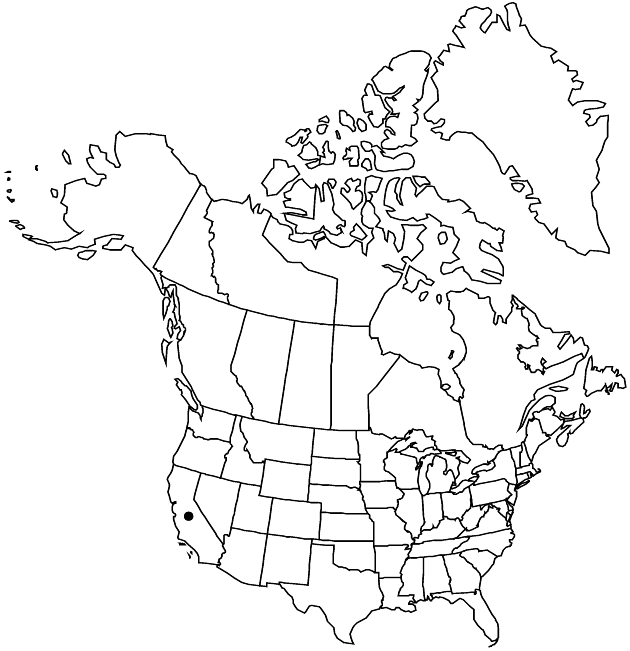Difference between revisions of "Lagophylla glandulosa"
Proc. Amer. Acad. Arts 17: 219. 1882.
Endemic
Synonyms: Lagophylla glandulosa subsp. serrata (Greene) D. D. Keck
FNA>Volume Importer |
imported>Volume Importer |
||
| (6 intermediate revisions by 2 users not shown) | |||
| Line 6: | Line 6: | ||
|place=17: 219. 1882 | |place=17: 219. 1882 | ||
|year=1882 | |year=1882 | ||
| + | }} | ||
| + | |special_status={{Treatment/ID/Special_status | ||
| + | |code=E | ||
| + | |label=Endemic | ||
}} | }} | ||
|basionyms= | |basionyms= | ||
| Line 11: | Line 15: | ||
|name=Lagophylla glandulosa subsp. serrata | |name=Lagophylla glandulosa subsp. serrata | ||
|authority=(Greene) D. D. Keck | |authority=(Greene) D. D. Keck | ||
| + | |rank=subspecies | ||
}} | }} | ||
|hierarchy=Asteraceae;Asteraceae tribe Heliantheae;Asteraceae (tribe Heliantheae) subtribe Madiinae;Lagophylla;Lagophylla glandulosa | |hierarchy=Asteraceae;Asteraceae tribe Heliantheae;Asteraceae (tribe Heliantheae) subtribe Madiinae;Lagophylla;Lagophylla glandulosa | ||
| Line 26: | Line 31: | ||
|elevation=10–900 m | |elevation=10–900 m | ||
|distribution=Calif. | |distribution=Calif. | ||
| − | |discussion=<p>Lagophylla glandulosa comprises spring and summer–fall flowering populations that occur widely in the northern Great Valley and surrounding foothills of the North Inner Coast Ranges, Cascade Range, and Sierra Nevada.</p> | + | |discussion=<p><i>Lagophylla glandulosa</i> comprises spring and summer–fall flowering populations that occur widely in the northern Great Valley and surrounding foothills of the North Inner Coast Ranges, Cascade Range, and Sierra <i>Nevada</i>.</p> |
|tables= | |tables= | ||
|references= | |references= | ||
| Line 35: | Line 40: | ||
-->{{#Taxon: | -->{{#Taxon: | ||
name=Lagophylla glandulosa | name=Lagophylla glandulosa | ||
| − | |||
|authority=A. Gray | |authority=A. Gray | ||
|rank=species | |rank=species | ||
| Line 49: | Line 53: | ||
|publication title=Proc. Amer. Acad. Arts | |publication title=Proc. Amer. Acad. Arts | ||
|publication year=1882 | |publication year=1882 | ||
| − | |special status= | + | |special status=Endemic |
| − | |source xml=https:// | + | |source xml=https://bitbucket.org/aafc-mbb/fna-data-curation/src/2e0870ddd59836b60bcf96646a41e87ea5a5943a/coarse_grained_fna_xml/V19-20-21/V21_641.xml |
|tribe=Asteraceae tribe Heliantheae | |tribe=Asteraceae tribe Heliantheae | ||
|subtribe=Asteraceae (tribe Heliantheae) subtribe Madiinae | |subtribe=Asteraceae (tribe Heliantheae) subtribe Madiinae | ||
Latest revision as of 21:13, 5 November 2020
Plants 10–100(–150) cm (weakly self-incompatible); branching excurrent, distal stems usually sparsely to densely stipitate-glandular, rarely eglandular. Leaves: blades green or gray-green, distal stipitate-glandular, glands yellow or golden. Heads in paniculiform arrays. Calyculi of 3–5 bractlets. Involucres obconic. Phyllaries 5–7 mm, hirtellous to piloso-hirsute on angles, hairs ± patent to antrorsely curved, 0.3–1+ mm. Ray laminae 7–13 mm. Cypselae glossy. 2n = 14.
Phenology: Flowering May–Nov.
Habitat: Grasslands, openings in chaparral and woodlands
Elevation: 10–900 m
Discussion
Lagophylla glandulosa comprises spring and summer–fall flowering populations that occur widely in the northern Great Valley and surrounding foothills of the North Inner Coast Ranges, Cascade Range, and Sierra Nevada.
Selected References
None.
Lower Taxa
None.
